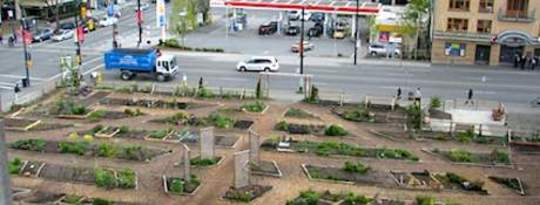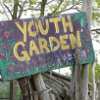
One of my first awakenings to the myriad benefits of community gardens was when the community police officer in a troubled neighborhood in Vancouver helped get one started. She wanted a project for the homeless people hanging around the neighborhood. They embraced it eagerly — a chance to care for something, do something positive, to witness the fruits (actually, vegetables) of their labor. She said the only problem was that so many people wanted to water the plants all the time.
Another community garden in Vancouver is on an abandoned lot a block away from the highest-crime transit station in the city. It used to be littered with needles and condoms. Today, it's a proud little garden. Once when I went by, I talked to a gaunt, strung-out young woman. Her red nail polish was chipped, and she wore a black mock-leather coat as she squatted at the edge of a raised bed, carefully repotting vegetable seedlings in a zoned-out kind of way. She said she came to the garden and did these little tasks because it made her feel good.
You don't need a lot of skin to do something useful at a community garden, and you don't have to commit a lot of time to produce results you can actually see.
Growing Community One Person at a Time
Gardeners love to talk about their plants, and community gardens can get conversations started. A friend of mine who started growing vegetables on the city-owned boulevard outside her house (encouraged in Vancouver and some other cities) said hardly anyone walked by without stopping to chat.
Get The Latest By Email
Another community garden in Vancouver's poorest neighborhood — home to the city's highest concentration of low-income housing and drug addiction — is a little oasis of green between two older buildings that are continually struggling for retail tenants. It has to be kept fenced off most of the time, but at least it's there, growing a bit of food, bringing a flicker of green pride to a destitute street.
Community Gardens Raise Property Values
The transformation of a blighted abandoned property into a community garden has a measurable economic impact. A study in New York found that opening a community garden increases property values ("a statistically significant positive impact") within 1,000 feet of the garden. And the impact increases over time.
A similar study in Milwaukee found that residents are willing to pay more to live near a community garden, driving up the market value of properties within a three-block radius of a community garden. That study went so far as to calculate the increased taxes to the city from the higher property values. They calculated that the average community garden contributes $8,880 in annual tax revenue to a city.
Community Gardens Decrease Crime
 Other studies have shown that the presence of vegetable gardens in inner-city neighborhoods is positively correlated with decreases in crime, trash dumping, juvenile delinquency, fires, violent deaths, and mental illness. A simpler and more measurable economic impact of community gardens is the money saved in mowing and maintenance costs when a volunteer-run garden takes over space in a publicly financed park.
Other studies have shown that the presence of vegetable gardens in inner-city neighborhoods is positively correlated with decreases in crime, trash dumping, juvenile delinquency, fires, violent deaths, and mental illness. A simpler and more measurable economic impact of community gardens is the money saved in mowing and maintenance costs when a volunteer-run garden takes over space in a publicly financed park.
Health authorities concerned about soaring costs of obesity and diabetes love community gardens. They directly address the two main solutions to those epidemics: exercise and better diet. Research shows that urban gardeners and their families consume more fruits and vegetables, have reduced grocery bills, and supply culturally valued fruits and vegetables in ethnic communities. (To keep the money-savings in perspective, though, keep in mind this comment from a woman tending her plot in a beautiful seaside garden in White Rock, B.C.: "I'm certainly not doing this to save money — I spent as much on my organic bean seeds as it costs me to buy a big bag of fresh organic beans from Costco.")
Community Gardens As Political Power
Community gardens can also give new immigrants a chance to position themselves as local experts. In Montreal, a McGill University project called Making the Edible Landscape found that immigrants from India and Bangladesh came to community gardens with agricultural knowledge that enabled them to drastically increase a plot's yield (such as building trellises to triple available growing space).
Some disenfranchised groups see community gardens as a path to political power. "In Detroit, a lot of gardeners do it for political reasons — it's a slap in the face for agri-business, and a way to control their own food security," says Monica White, a sociology professor at Wayne State University. "Growing food is a way for African Americans to engage in a struggle for freedom. Resistance usually acts against institutions. With gardening, we take the initiative into our own hands."
Malik Yakini chairs the Detroit Black Community Food Security Network, an organization that operates D-Town, two acres of gardens in the largest park in the city, on land leased from the city for 10 years. Yakini, speaking at the Farm to Cafeteria conference in May 2010 said, "In most cities, community garden work is being done in black and Latino communities mostly by young white people with a missionary mentality.... We speak openly about white supremacy. We're unabashed advocates for self-sufficiency in the Afro-American community."
Self-Sufficiency in Urban Communities
Self-sufficiency means food, and a study in Philadelphia showed community gardens grow a lot of it, even though most gardens are broken up into separately managed small plots, not geared for high production. All the same, a University of Pennsylvania research team found 220 food-producing community gardens in the city in 2008; an estimated 2.2 million pounds of food was produced, worth around $4.4 million. Most of it wasn't grown for sale: "The majority of gardeners in low-wealth communities distribute a significant proportion of their harvest to extended family, neighbors, fellow church members, and strangers who are hungry; writes Professor Domenic Vitiello.
The Earlscourt Park Community Garden in Toronto is a consolidated community garden: a single 8,000-square foot garden that is geared to food production. Community members grow, tend and harvest more than 2,000 pounds of organic produce for use in The Stop's food distribution programs.
View video about The Stop:
Urban Ag at The Stop from The Stop Community Food Centre on Vimeo.
This article was excerpted with permission from the book:
 The Urban Food Revolution: Changing the Way We Feed Cities
The Urban Food Revolution: Changing the Way We Feed Cities
by Peter Ladner.
Reprinted with permission of the publisher, New Society Publishers. ©2011. http://newsociety.com.
Click here for more info and/or to order this book on Amazon.
About the Author

Peter Ladner is a Fellow at the Simon Fraser University Centre for Dialogue focusing on Planning Cities as if Food Matters. He was first elected to Vancouver City Council in 2002 and re-elected in 2005. In 2005 he was elected Vice Chair of the Metro Vancouver Board. In 2008 he ran for Mayor of Vancouver. Peter is a columnist in the Business in Vancouver Media Group, where he co-founded the award-winning Business in Vancouver weekly newspaper in 1989. He has more than 35 years of journalistic experience in print, radio and television and is a frequent speaker on food, business and community issues. Visit his website at www.peterladner.ca/







